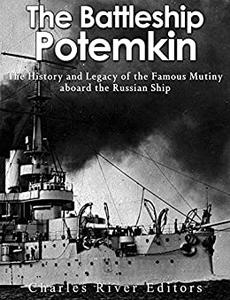
Free Download The Battleship Potemkin: The History and Legacy of the Famous Mutiny aboard the Russian Ship by Charles River Editors
English | February 3, 2017 | ISBN: 1542904145 | 52 pages | EPUB | 1.17 Mb
*Includes pictures
*Includes accounts of the mutiny
*Includes online resources and a bibliography for further reading
"The hero is the sailors' battleship, the Odessa crowd, but characteristic figures are snatched here and there from the crowd. For a moment, like a conjuring trick, they attract all the sympathies of the audience: like the sailor Vakulinchuk, like the young woman and child on the Odessa Steps, but they emerge only to dissolve once more into the mass. This signifies: no film stars but a film of real-life types." -Adrian Piotrovsky, writing for the Leningrad newspaper Krasnaia gazeta
Russia entered the 20th century in possession of nearly all of the prerequisites for an empire of historic proportions. The tsar presided over almost one-sixth of the world's land masses extending from a culturally European West to an Asian East, with vast expanses of forest steppe and tundra reaching from Poland to the Pacific Ocean. Land-based military forces reflected the potency of a globally dominant nation, and the disparate borders offered several strategic advantages for the navy, including Sevastopol in Crimea, and Odessa on the Black Sea. Virtually all great empires have built and maintained advanced navies, from ancient times to the modern era of Spain, but Russia lagged behind in the modern armadas typical of world-shaping societies. This was due, in part, to the enormity of her four major coastlines. To the north stretched a broad icy expanse, thousands of miles in breadth. To the east lay a second vast coastline from the Bering Strait to the south, where it met territory controlled by leading Asian powers. The country possessed sizable inland coasts in the Black Sea requiring a fleet of its own, and a geographically and culturally distinct Baltic region. Many of Russia's major cities were situated far to the interior, St. Petersburg being the exception, and had always enjoyed the natural protection of a wide swath of wilderness and climate resistant to invasion. That fact notwithstanding, an up-to-date naval force was needed in response to exterior threats on frontier borders far from Moscow. Despite a membership of nearly 60,000 sailors by the turn of the 20th century, making Russia's seagoing force the fourth largest in the world, the crews were deficient and poorly treated, drawn largely from conscripted factory workers and serfs who earned far less in wages than they would have at home. This made them particularly susceptible to anti-tsarist ideologies, and in particular, "Marxist agitators." Likewise, most among the officer class were political appointees from the land-based aristocracy, who lacked the general skill and sensitivity with which to lead men into battles they themselves had never experienced.
Despite Russia's imposing image in the world, less apparent weaknesses within the tsarist government threatened the country's stability. The autocratic system had stood firm for several hundred years, but only in the 18th and 19th centuries was it surrounded by emerging democracies, alluring to working classes around the world. Multiple ethnicities from lands conquered in previous centuries maintained an almost provisional membership when faced with the allure of their home empires.
As with the rest of the population, naval forces that had come to be persuaded of anti-tsarist arguments did not do so within a vacuum. The accumulated unrest throughout the country could provoke a more organized message within the confines of a single warship, and indeed it eventually resulted in the first far-reaching eruption in the Black Sea Fleet aboard the battleship Potemkin. Several events in the early 20th century led to an eroding loyalty among Russian military forces, and Potemkin was the first modern ship to reveal it, an act that would bring it fame and make it the subject of some of the most well-known works of film and literature in Russian history.
